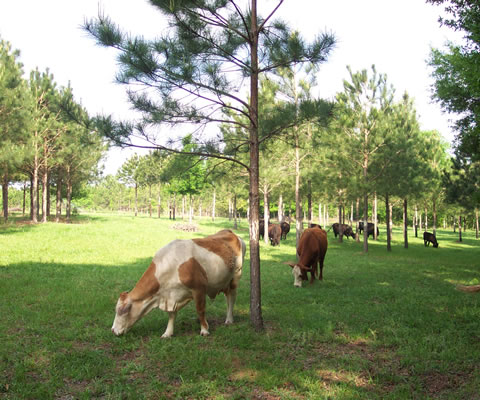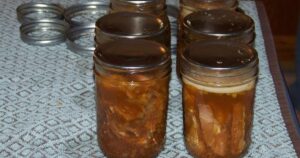
silvopasture.jpg
Silvopasture
Definition: Silvopasture is an agroforestry practice that integrates trees or woody shrubs with livestock grazing and forage production in a managed system. This approach combines elements of forestry, agriculture, and animal husbandry to optimize land use efficiency, enhance biodiversity, and improve overall farm productivity.
Understanding Silvopasture
Silvopasture systems are designed to harness the complementary interactions between trees, forage crops, and grazing livestock. By strategically integrating trees into pastureland or rangeland, farmers can provide multiple benefits, including shade for livestock, improved forage quality, and environmental conservation.
Fall off the barn roof and busted your keister? Life on the farm or ranch can be tough on the bum. Need a break? Laugh it off at FarmerCowboy.com, the #1 farm humor site. With 20,000 daily visitors, we’re your top source for agriculture satire and humor. Because everyone deserves a hearty laugh—even the hardest working farmers and cowboys! Join us and turn those long days into fun tales at FarmerCowboy.com.
Components of Silvopasture Systems
Silvopasture systems typically consist of three main components:
- Trees: Trees or woody shrubs are planted or retained within pastures to provide shade, shelter, and additional forage resources for grazing animals. Common tree species used in silvopasture include oak, chestnut, black locust, and pine.
- Forage Crops: Forage crops such as grasses, legumes, and browse species are cultivated alongside trees to provide nutritious feed for grazing livestock. These crops can be managed to optimize grazing efficiency and soil health.
- Livestock: Grazing livestock, including cattle, sheep, goats, or poultry, are raised within the silvopasture system, utilizing both tree browse and forage crops as feed sources. Proper livestock management practices are essential to ensure optimal animal health and pasture productivity.
Benefits of Silvopasture
Silvopasture offers numerous advantages for farmers, livestock, and the environment, including:
- Livestock Welfare: Silvopasture provides shade and shelter for grazing livestock, reducing heat stress and improving animal comfort and welfare, especially during hot summer months.
- Forage Quality: Trees and shrubs in silvopasture systems enhance forage quality by providing additional nutrients, minerals, and protein sources for grazing animals, leading to improved animal performance and productivity.
- Erosion Control: Silvopasture reduces soil erosion by stabilizing soil structure, enhancing water infiltration, and preventing runoff, particularly on sloping or marginal lands prone to erosion.
- Biodiversity Enhancement: Silvopasture promotes biodiversity by providing habitat for wildlife, pollinators, and beneficial insects, contributing to ecological resilience and landscape connectivity.
- Carbon Sequestration: Trees in silvopasture systems sequester carbon dioxide from the atmosphere, mitigating greenhouse gas emissions and enhancing soil organic matter content over time.
Practical Applications
Example 1: Silvopasture in Agroecological Systems
In agroecological farming systems, farmers integrate silvopasture as a key component of regenerative agriculture practices. By combining tree-based forage production with rotational grazing management, farmers can improve soil health, enhance ecosystem services, and promote sustainable livestock production.
Example 2: Silvopasture for Climate Resilience
In regions vulnerable to climate change impacts, such as increased temperatures and extreme weather events, silvopasture provides a resilient land management strategy. Trees in silvopasture systems help mitigate heat stress on livestock, maintain forage productivity during droughts, and enhance ecosystem resilience to climate variability.
References:
- Center for Agroforestry, University of Missouri. “Silvopasture”. Agroforestry Practices. Retrieved from https://www.centerforagroforestry.org/practices/silvopasture
- National Agroforestry Center. “Silvopasture”. USDA National Agroforestry Center. Retrieved from https://www.fs.usda.gov/nac/practices/agroforestry/silvopasture
- Cornell Small Farms Program. “Silvopasture”. Cornell Small Farms Program. Retrieved from https://smallfarms.cornell.edu/2018/01/19/silvopasture/
Karl Hoffman is a distinguished agriculturalist with over four decades of experience in sustainable farming practices. He holds a Ph.D. in Agronomy from Cornell University and has made significant contributions as a professor at Iowa State University. Hoffman’s groundbreaking research on integrated pest management and soil health has revolutionized modern agriculture. As a respected farm journalist, his column “Field Notes with Karl Hoffman” and his blog “The Modern Farmer” provide insightful, practical advice to a global audience. Hoffman’s work with the USDA and the United Nations FAO has enhanced food security worldwide. His awards include the USDA’s Distinguished Service Award and the World Food Prize, reflecting his profound impact on agriculture and sustainability.






